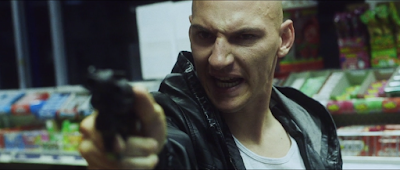Short Film
#3: Unleaded
Director:
Luke Davies
Issues:
Drug Abuse, Crime, Poverty, Working Class
Themes: Theft, Misinterpretation,
Parallel editing
has been used to create comedic effect in this short, which also helps the
audience to better understand the narrative. This suggests to the audience that
the switch to and from the two scenes is creating meaning by implying they are
connected and that the drug addicts will meet the thugs as the narrative of the
film progresses. This links the characters together, and being in the same
place may emphasise the result of them both practicing illegal activity. This
therefore, supports the issue of crime.
Furthermore, the
editing style may exaggerate the protagonist’s point of view within the short.
Long takes justify the use of ellipsis in the narrative, to keep the audience
from getting bored, as well as to mimic the effect that drugs have on the mind
of the protagonist. Long takes might emphasise delayed reactions and lack of
awareness in his surroundings, whilst ellipsis may make clear his inability to
recall recent events or understanding of time. This ties in with the issue of
drug abuse.
The non-diegetic
sound creates verisimilitude, which allows the audience to see the issues and
themes surrounding poverty and low economic status, specifically the dialogue.
The scene inside the shops allows audiences to hear the vulgar language and
tone of voice used, which may be associated with working class social groups.
Whilst the protagonist uses this language and angry manner too, as it creates
an arguably more effective opposition between him and the thugs, the companions
that he drove to the petrol station with take on a contrasting tone of voice.
When cutting from a scene in their car to a scene in the shop, the pair in the
car seem very relaxed and somewhat spaced out compared to the angry men in the
shop. Levi Strauss’ ‘binary opposition’ theory may be applied here, as their
accents also appear to be different to those trying to rob the shop, which
might create an opposition between regionalities. This is supported by the fact
that their friend, who speaks in similar tone to the thugs, also argues with
them whilst he’s in the shop.
Camerawork
creates contrast between the two groups that have pulled up at the petrol
station and the mood that is created because of it. The woman in the car on her
own is portrayed using much closer shots as compared to the two men in the car.
This emphasises her contemplation and worry as she waits for the other two
antagonists to finish thieving the shop and to leave. The two men in the car
are often seen in a two shot, which requires a wider shot to fit them into.
This helps to exaggerate their body language and the fact that they are under
the influence of drugs. This creates a lighter mood compared to the female in
the neighbouring car, especially as one shot shows her face through the
interior mirror, which may emphasise how aware she has to be to stay out of
trouble, which conflicts with the two males laid back appearance and mood.
Furthermore, the influence of drugs and lack of awareness is shown through the
male protagonist’s close up in the shop, in which the main thug holding a gun
is depicted in the shallow focus in the background. This highlights his lack of
awareness and supports the issue of drug use.
Marilyn Milgrom’s
The Script may be applied to Unleaded,
as it has a world, a character, and a problem. The world for this short is the
petrol station. The character is the protagonist who has entered the petrol
station shop in search for food. His problem is that his friends are
unsympathetic and force him into the petrol station to buy them food. Little
does he know, he is also being held at gunpoint. Milgrom also states that one
of three things must drive the character through the narrative; a want, a need,
or an obligation. In this case, the man’s want to find something to eat is what
drives the narrative forward. She also makes a point that it is important to
make the end of the film meaningful by choosing the best point of view to tell
the story from. This short film portrays the protagonist as the best point of
view, as he creates the comedic effect through the way that he talks to his
friends and supposedly the thug, and his lack of awareness of the whole event.









No comments:
Post a Comment